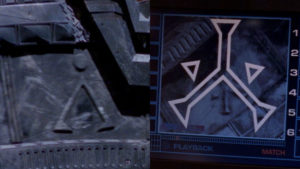Author Archives: David Gian-Cursio
General Reel — Spring 2023
Stargate 2020 Effects (Film Version)
“Stargate 3.0 Effects (Film Version)” for Lightwave 2020, Released December 25, 2021 (CC0) —142 MB
After a year and a half, I’m running out of steam on the Stargate project for now, so I pushed myself to finish up the part I was currently working on, the version of the “kawoosh,” “strudel,” and “puddle” effects as seen in the movie.
Continue readingStargate 2020 (Pegasus Version)
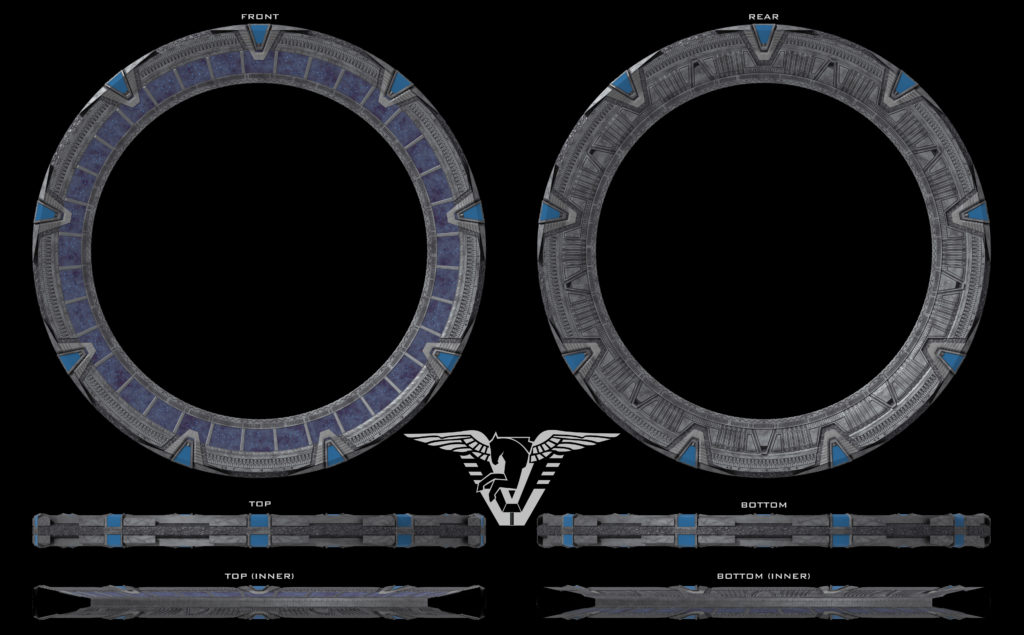
“Stargate 3.1 (Pegasus Version)” for Lightwave 2020, Released July 30, 2021 (CC0) —53 MB
Conversion Kits:
- FBX Version (CC0)—93 MB
- FBX Animation Templates (CC0)—0.8 MB
- OBJ Version (CC0)—101 MB
- Texture Reference (CC0)—67 MB
After over a year, I’ve reached the end of my 2020 pandemic modeling project with the completion of the version of the stargate used in Stargate Atlantis. Alongside the movie and SG-1 versions, that makes a complete set for this basic design.2The Universe version being a totally different design, and the Origins version being intended to match the movie version, even if it didn’t quite hit the mark perfectly. While I don’t think I’m quite done with Stargate just yet, I’m probably done with modeling actual stargates for a while.
Continue reading
| ↑1 | Atlantis Expedition Logo by CmdrKerner |
|---|---|
| ↑2 | The Universe version being a totally different design, and the Origins version being intended to match the movie version, even if it didn’t quite hit the mark perfectly. |
“Comparing Notes,” Animated
Stargate 2020 (Milky Way Version)
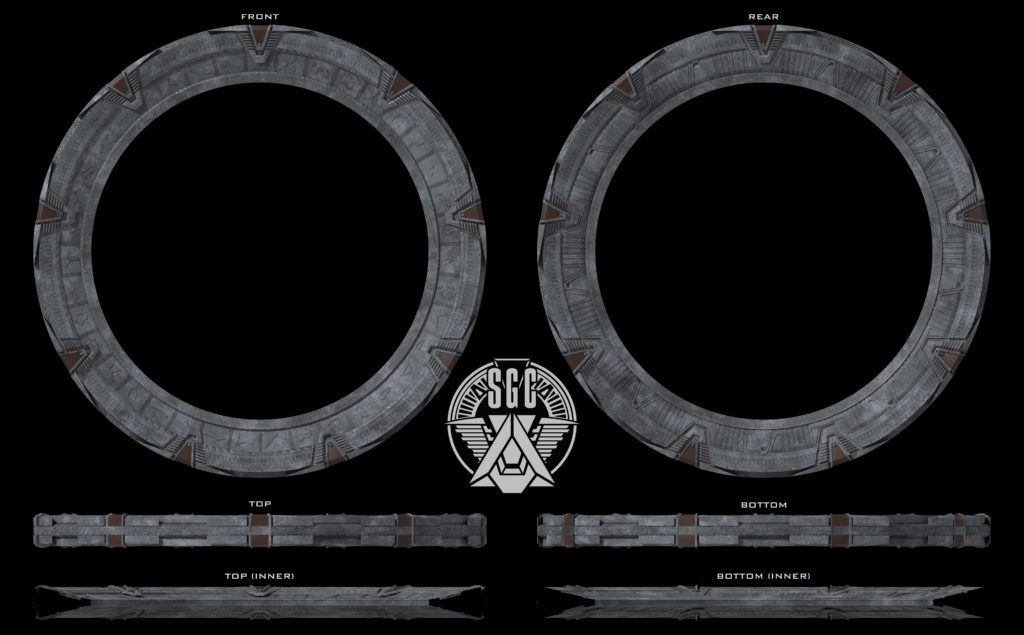
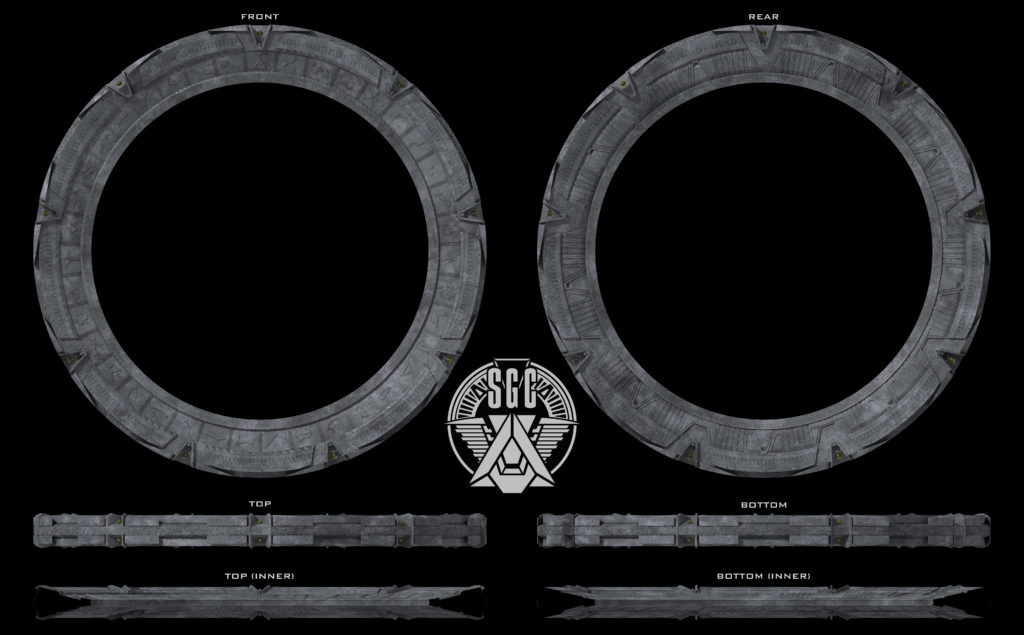
“Stargate 3.0 (Milky Way Version)” for Lightwave 2020, Released March 28, 2021 (CC0) —80 MB
Conversion Kits:
Main Model
Inner Rings With Alternate Origin Symbols
Continuing with my work on building a new stargate model, and in advance of the Atlantis-style ‘gate, we have the flagship version, the stargate as it appeared in the series Stargate SG-1, give a take a few alterations and enhancements.
Continue reading
| ↑1 | SGC Logo by mikepjr |
|---|
Tech the Tech: How to Dial a Stargate
Or, “Mother, the chevrons are locking!”
Considering it’s just a big, spinning wheel, there’s actually a surprising amount of ambiguity about exactly how the Milky Way version of the Stargate dials. The basics are obvious. There’s an inner ring, which rotates alternatively clockwise and counterclockwise to indicate specific symbols on it, each of which is represented by one of nine corresponding chevrons on the main ring of the device. The chevrons are numbered one through seven, proceeding clockwise, ending with seven at the top, and skipping the bottom two chevrons.1In the subsequent television shows, we saw eight- and nine-chevron addresses. The nine-chevron address engaged each chevron in clockwise order, with the bottom-right chevron becoming chevron four and the normal chevron four being chevron six, and so on. The implication in “The Fifth Race,” the first episode where it was done, is that the first six symbols encode under the normal chevrons, while the additional seventh symbol encodes at the bottom right chevron (briefly seen on a computer screen), with chevron eight at the top, which is confirmed by comparing the visible symbols on the Atlantis stargate in the episodes “No Man’s Land” and “The Pegasus Project” with the published eight-symbol address for Earth.
So the question left is, exactly what position on the main ring indicates which symbol is being encoded or locked by a given chevron?
Continue reading
| ↑1 | In the subsequent television shows, we saw eight- and nine-chevron addresses. The nine-chevron address engaged each chevron in clockwise order, with the bottom-right chevron becoming chevron four and the normal chevron four being chevron six, and so on. The implication in “The Fifth Race,” the first episode where it was done, is that the first six symbols encode under the normal chevrons, while the additional seventh symbol encodes at the bottom right chevron (briefly seen on a computer screen), with chevron eight at the top, which is confirmed by comparing the visible symbols on the Atlantis stargate in the episodes “No Man’s Land” and “The Pegasus Project” with the published eight-symbol address for Earth. |
|---|
Stargate Command Plaque
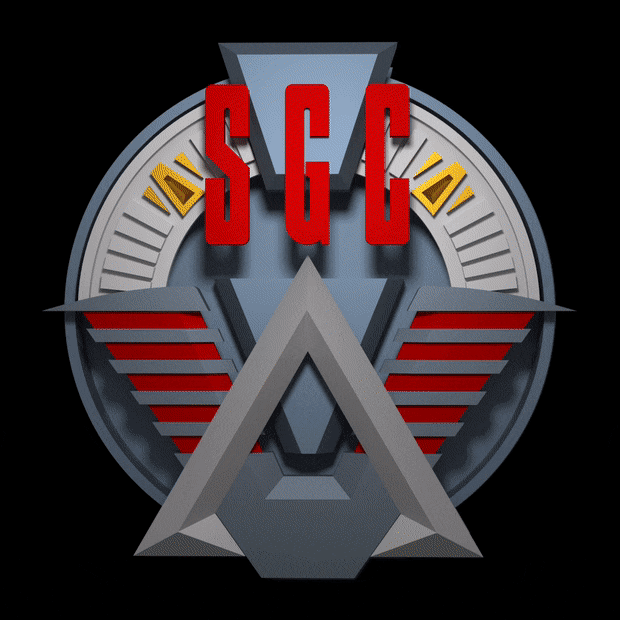
“SGC Logo Plaque” for Lightwave 2020 (FBX & OBJ Included), Released March 15, 2021 (CC0)—279 KB
As a quick little side-project, the other night I built the SGC Plaque. Joseph Mallozzi, who was a writer and producer on the TV shows, has been posting high-res behind-the-scenes photos, concept art, and documents since the shows were still on the air, and recently posted a construction diagram of the plaque, which made it pretty easy to model in only an hour or two, most of which was spent squinting at the measurements and comparing with some photos of the finished plaque to see how things changed between the drawing and the actual piece.
There was also a 3D rendered version used on the show as a screensaver and decorative element on computer displays which was colored differently, so I made both versions. I didn’t sweat getting the textures exactly right (and there were some shape differences with the digital version I didn’t bother changing), just going for the spirt instead of a perfect duplicate. The gaudy ’90s texturing is pretty rough, and now we’ve entered a glorious era where flat color in CGI actually look okay.

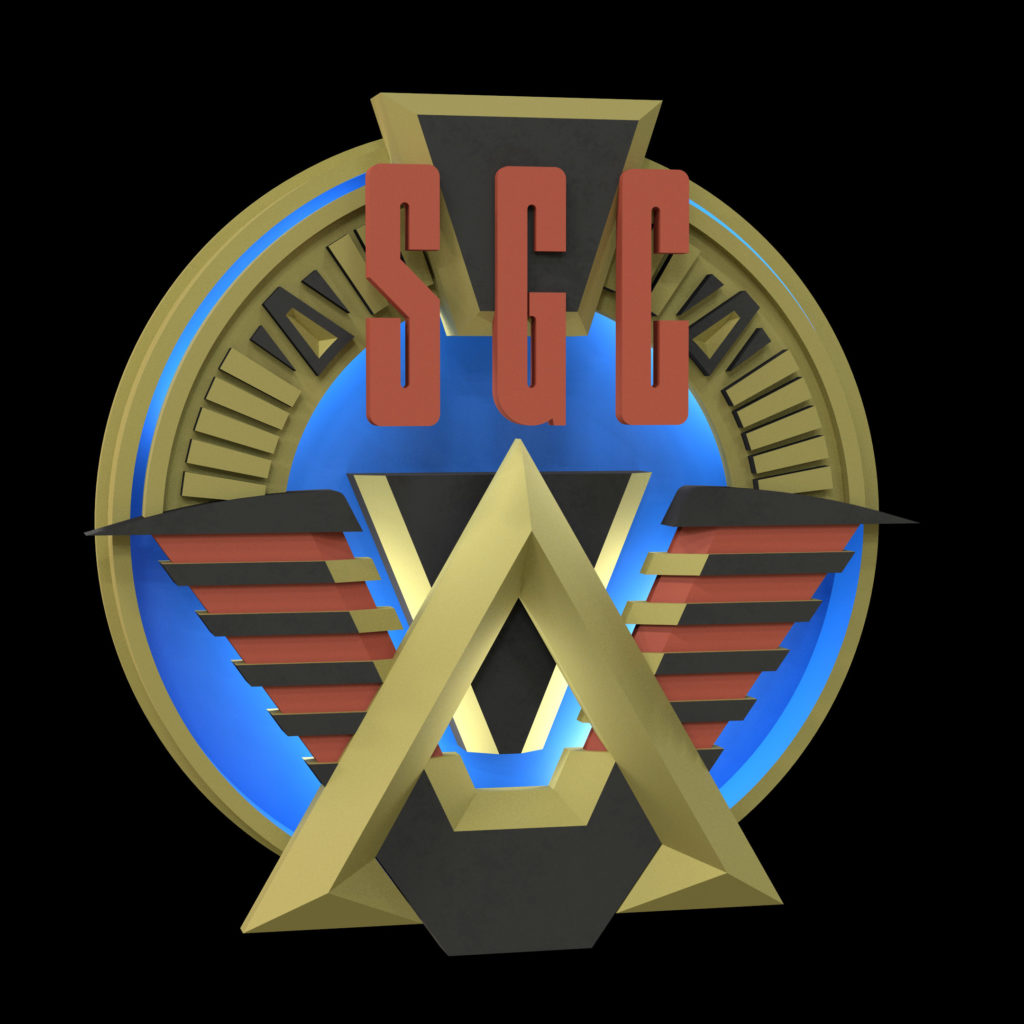
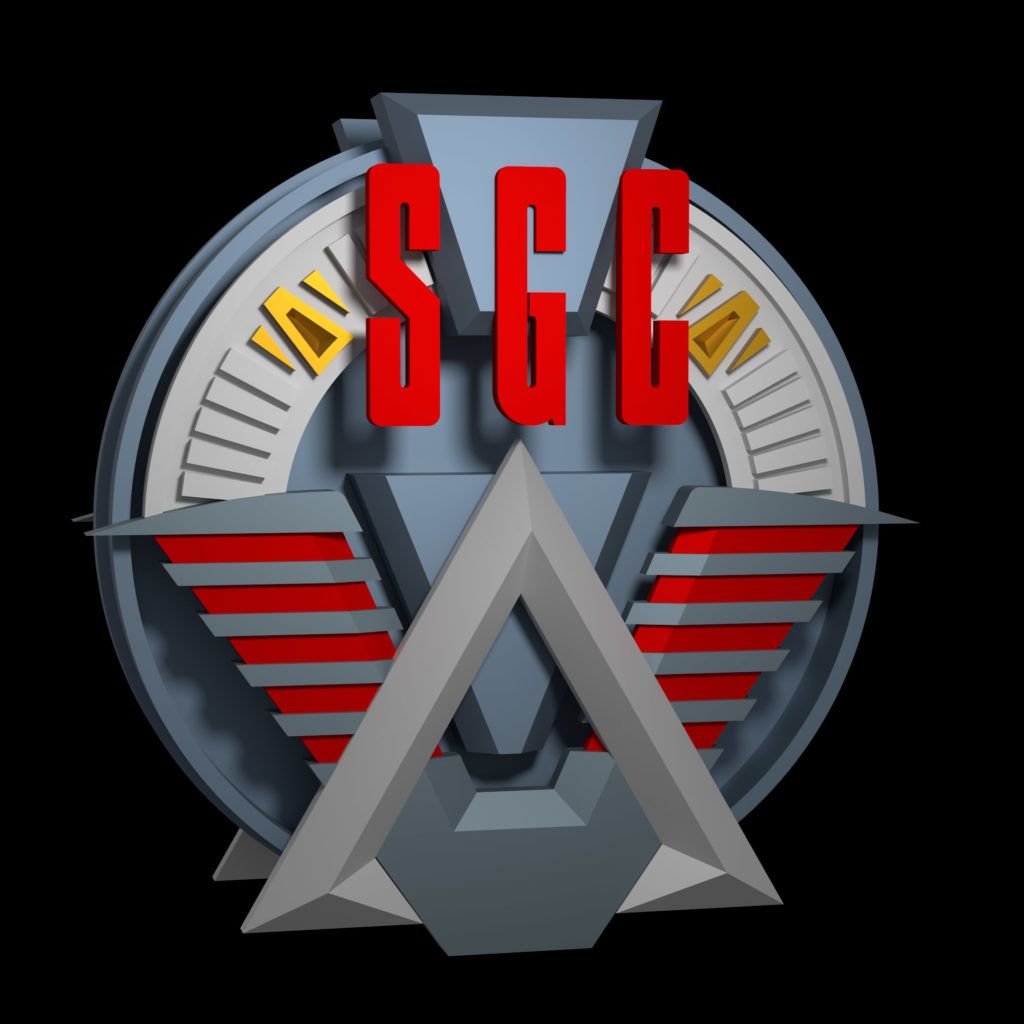
Stargate 2020 (Film Version)
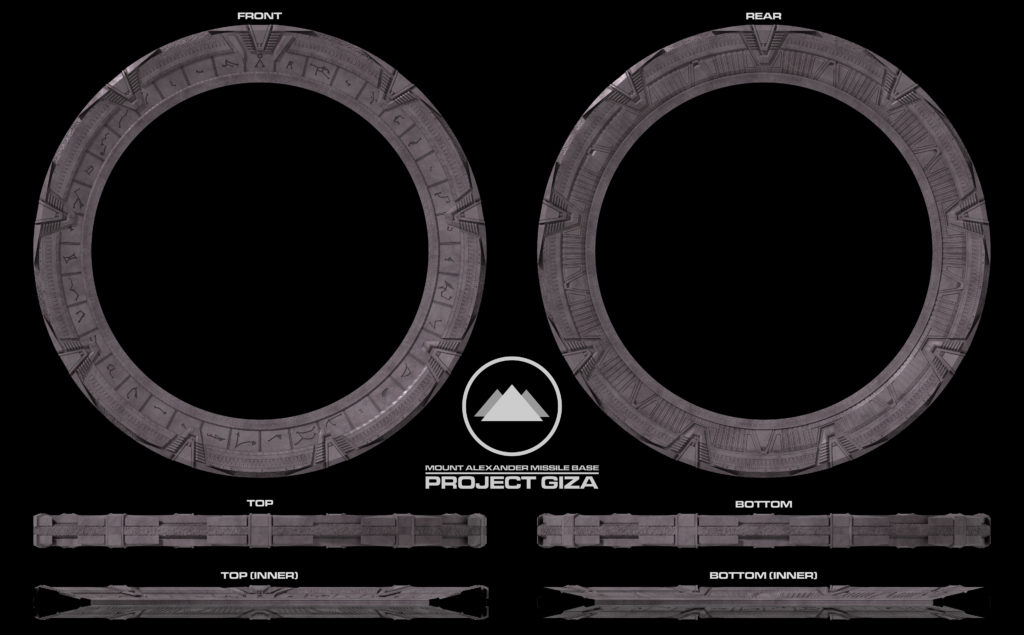
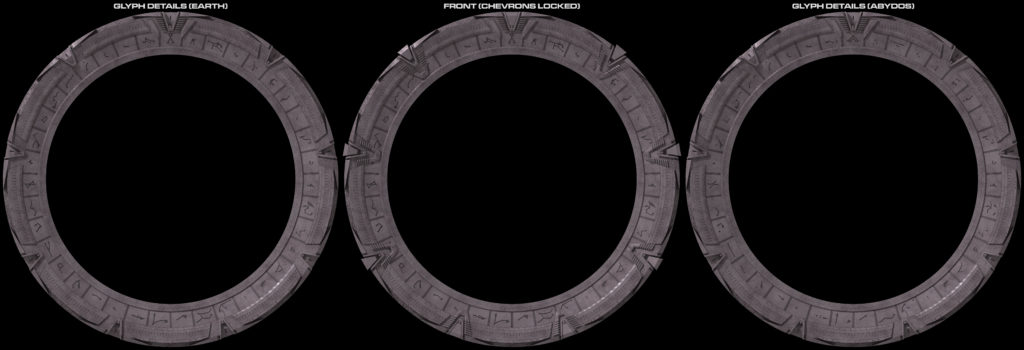
“Stargate 3.1 (Film Version)” for Lightwave 2020, Released March 22, 2021 (CC0) —44 MB
Conversion Kits:
FBX Version (CC0)—78 MB
FBX Animation Templates (CC0)—0.1 MB
OBJ Version (CC0)—87 MB
Texture Reference (CC0)—24 MB
Since last summer, I’ve been working on a new 3D model of the stargate in Lightwave, my third attempt. Since I last built a stargate model in 2006 (with small updates afterward), my skill as a modeler has increased, and reference material is far more plentiful. That includes behind-the-scenes photos, low-res but still useful construction diagrams from auction websites, HD home video releases of the movies and television shows, and, most importantly, high-res photos from Les Enfants de Mac Gyver, a group creating a duplicate of the SG-1 stargate setpiece using pieces of the screen-used version purchased at auction as well as their own copious research. There are many sections of this model where I simply wouldn’t have been able to even guess at what went where without their detailed and plentiful photos of their stargate being assembled, disassembled, and otherwise worked on.
Continue readingTech the Tech: The Glyphs on the Abydos Stargate
I’ve been working on a new 3D model of the stargate. For the moment, I’ve been working in parallel on the variations seen in the original movie and the SG-1 television series, since they share nearly all of the same parts.1The Atlantis stargate, while superficially similar, actually has enough unique aspects that it makes more sense for me to build a separate model based on the parts I’ve made for the movie/SG-1 version. One of the elements I’d like to recreate is that in the original movie, the stargate on the alien planet Abydos had different symbols on its inner ring than the one on Earth. I’ve never seen any listing of these alternate symbols, so I investigated the film to see what I could figure out.
NO MATTER WHERE YOU GO, THERE YOU ARE
First, let’s talk about the point of origin symbol. For the TV series Stargate SG-1, the concept of the stargate was simplified, so that rather than each stargate having a unique set of symbols on it based on the stars as seen from its particular location in the universe, every stargate used the same symbols, based on the constellations as seen from Earth, aside from one unique symbol, which represented that particular stargate itself. Finding the symbol that represented the “point of origin” was a major plot-point in the film, though it was only occasionally touched on in the series; unique point of origin symbols were designed for other stargates just twice during the entire run of the show,2The stargate in Antarctica in “Solitudes,” and the stargate on the planet where the population was living a VR simulation in “The Gamekeeper” with other planets normally having one of the regular 38 “address” symbols substituted in their place (another reason I wanted to recreate the Abydos stargate was to have a supply of plausible stargate symbols to use as point of origin symbols for alien stargates on my SG-1 gate model).
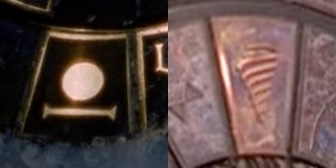
In SG-1, the origin symbol for the stargate used by Earth during most of the show was carried over from the film, a triangle pointing upward at a circle, representing a pyramid with the sun directly above it.3The pyramid symbol, and all the other stargate symbols, were remade from scratch for the series stargate setpieces, and don’t precisely match the symbols used in the movie in size, orientation, or proportion. The symbol for Abydos in the series was three equilateral lines extending out from a center point, with two triangles flanking the vertical line.
That is similar to the way the symbol was described in the film (a pyramid with the three moons of Abydos above it), but it doesn’t quite look like the drawing of the symbol we saw in the film, which consisted of two wide, stacked triangles. And, in fact, there is a symbol of two wide, stacked triangles on the Abydos stargate in the movie. So where’d the symbol used in the TV show come from?
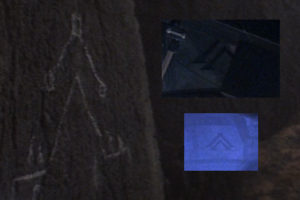
| ↑1 | The Atlantis stargate, while superficially similar, actually has enough unique aspects that it makes more sense for me to build a separate model based on the parts I’ve made for the movie/SG-1 version. |
|---|---|
| ↑2 | The stargate in Antarctica in “Solitudes,” and the stargate on the planet where the population was living a VR simulation in “The Gamekeeper” |
| ↑3 | The pyramid symbol, and all the other stargate symbols, were remade from scratch for the series stargate setpieces, and don’t precisely match the symbols used in the movie in size, orientation, or proportion. |

